October 31 – November 30, 2012
PICTURE OF THE MONTH: |
|
|
|
MBO gratefully acknowledges the support provided for winter 2012-2013 by Bird Protection Quebec, in the form of bird seed to keep the MBO feeders stocked throughout the season. |
| THIS PERIOD | THIS WINTER | 2012 TOTAL | SITE TOTAL | |
|---|---|---|---|---|
| # birds (and species) banded | 277 (15) | 277 (15) | 5606 (93) | 41357 (111) |
| # birds (and species) repeat | 100 (11) | 100 (11) | 1527 (62) | 7940 (70) |
| # birds (and species) return | 16 (5) | 16 (5) | 242 (30) | 1203 (38) |
| # species observed | 35 | 35 | 171 | 207 |
| # net hours | 118.5 | 118.5 | 10166.6 | 69265.7 |
| # birds banded / 100 net hours | 233.8 | 233.8 | 55.1 | 59.7 |
Note: table does not include nocturnal banding (owls)
Banders-in-charge: Bob Barnhurst, Simon Duval, Gay Gruner
Assistants: Richard Beauchamp, Nicolas Bernier, Jean Demers, Liette Fortier, Louise Gagné, Barbara MacDuff, Chris Murphy, Yves Payette, Clémence Soulard, Monique Venne
Notes: Fall ended on a high note with an influx of surprises over the final week of the season, and November delivered more excitement. On November 7 we banded the first White-winged Crossbill in MBO`s history, becoming the 111th species on our cumulative list – and the third new addition in two weeks, counting the Red-bellied Woodpecker and Bohemian Waxwing in the final week of the Fall Migration Monitoring Program. Overall it was a busy November, with 277 birds banded over the span of 10 visits. The 35 species observed is a bit below the usual count for November, but we know from past years that the count increases throughout winter, sometimes in unexpected ways. Pine Grosbeak was the only species observed for the first time this year, bringing the count for 2012 to 171 species. Returns have been abundant all year, and there were another 16 this month. The Downy Woodpecker, 8 Black-capped Chickadees, and 3 American Goldfinches are likely all local residents that simply hadn’t been caught during the Fall Migration Monitoring Program. However, the American Tree Sparrow and 3 Slate-colored Juncos were returns from previous years showing winter site fidelity – the sparrow back for its third winter in a row, and the juncos for the second, third, and fourth years respectively.
|
|
With the resumption of the winter program, we are again focusing effort on our feeder bird study. Once again, House Finch and American Goldfinch were among the most abundant species at MBO throughout November. We recaptured some of the individuals we banded last winter, and resighted some other House Finches wearing colour bands. We continued to deploy those bands on House Finches this month, but not on the goldfinches, as we realized after last winter’s pilot project that they are simply too small to be effective. Full details of the project are at this link, and if you are lucky enough to spot one of our birds, we encourage you to share your sightings with us through our reporting page.
|
|
While the finches were keeping us busy during the day, we also brought to a close another very successful owl banding season. By the end of the standard season on November 6, we had banded a record 235 Northern Saw-whet Owls, plus 10 individuals of four other species – including MBO’s first ever Barred, Long-eared, and Boreal Owls. All four Boreal Owls came over the final two nights of the standard season – a welcome reward after setting up a secondary site to target the species this fall. Supplemental owl banding continued until November 20, but migration was clearly past its peak, with only 11 saw-whets in the first week after the end of the standard season, and 3 the week after. The owling season is summarized in section 7 of the MBO 2012 annual report.
| # individuals banded | mean # individuals observed daily |
|---|---|
| 1. American Goldfinch (146) [3] | 1. Canada Goose (124) [1] |
| 2. House Finch (57) [1] | 2. European Starling (43) [3] |
| 3. Slate-colored Junco (24) [2] | 3. American Goldfinch (34) [10] |
| 4. Black-capped Chickadee (15) [9] | 4. American Robin (28) [5] |
| 5. Red-winged Blackbird (10) [6] | 5. Black-capped Chickadee (21) [8] |
| 6. White-throated Sparrow (6) [-] | 6. House Finch (16) [6] |
| 7. Northern Cardinal (4) [5] | 7. Red-winged Blackbird (14) [4] |
| 7. American Tree Sparrow (4) [4] | 8. Slate-colored Junco (12) [7] |
| 9. Common Redpoll (3) [-] | 9. Pine Siskin (9) [-] |
| 10. American Robin (2) [-] | 10. American Crow (5) [2] |
Goldfinches dominated the nets this month, accounting for over half of the birds banded. The number of House Finches was similar to last year at this time, and again much higher than in any other month. As usual, some late migrating juncos were banded in November, and this year the tail end of the chickadee migration also was apparent. Red-winged Blackbirds have been getting increasingly common at MBO in November, with the 10 individuals banded this year building on last year`s record of 8. Rounding out the top ten were smaller numbers of White-throated Sparrow, Northern Cardinal, American Tree Sparrow, Common Redpoll, and American Robin. The redpolls were the first banded in winter since 2010-2011, but followed up on the three banded in the final week of fall.
As usual, Canada Geese dominated the observations thanks to a flock of 800 on October 31, and smaller groups averaging a few dozen on other dates in November. European Starlings, American Robins, and Red-winged Blackbirds all were still seen in sizeable flocks on at least some dates. The influx of American Goldfinches at the nets was also reflected in the number observed daily, more than twice as many as in November 2011. The only species in the top ten this year that was different from last November was Pine Siskin (with Mallard dropping out).
|
|
December 1 – December 31, 2012
PICTURE OF THE MONTH: |
|
|
Note: table does not include nocturnal banding (owls)
| THIS PERIOD | THIS WINTER | 2012 TOTAL | SITE TOTAL | |
|---|---|---|---|---|
| # birds (and species) banded | 155 (8) | 432 (15) | 5761 (93) | 41512 (111) |
| # birds (and species) repeat | 41 (8) | 141 (13) | 1568 (63) | 7981 (70) |
| # birds (and species) return | 6 (5) | 22 (6) | 248 (30) | 1209 (38) |
| # species observed | 28 | 35 | 171 | 207 |
| # net hours | 24.0 | 142.5 | 10190.6 | 69289.7 |
| # birds banded / 100 net hours | 645.8 | 303.2 | 56.5 | 59.9 |
Banders-in-charge: Simon Duval, Gay Gruner
Assistants: Nicolas Bernier, Alison Hackney, Lisa Keelty
Notes: As usual, activity at MBO tapered off a bit in December, with only seven visits over the course of the month, and banding on just the first three of those. However, the feeders remained active, and the brief banding efforts were very productive, with over 150 birds banded in just 24 net hours! With nearly three months to go in winter, the 432 birds banded to date is just shy of the season record of 449 in winter 2010-2011. Surprisingly, all the species observed in December had already been recorded in November, so the count of species observed this winter remains stuck at 35, which is below average.
|
|
There were another six returns in December, again a mix of local residents and “true” returns showing fidelity to MBO as a wintering site. Among the local residents, the most noteworthy was a Black-capped Chickadee banded in September 2008, and recaptured every winter since except 2010-2011. In the other group, there were two American Tree Sparrows (one banded last winter, and the other the winter before), and a Slate-colored Junco recaptured for the first time since being banded in December 2009.
| # individuals banded | mean # individuals observed daily |
|---|---|
| 1. American Goldfinch (77) [1] | 1. European Starling (20) [2] |
| 2. House Finch (31) [2] | 2. American Goldfinch (18) [3] |
| 3. Common Redpoll (23) [9] | 3. House Finch (15) [6] |
| 4. American Tree Sparrow (13) [7] | 4. Common Redpoll (13) [-] |
| 5. Slate-colored Junco (6) [3] | 5. Black-capped Chickadee (11) [5] |
| 6. Black-capped Chickadee (2) [4] | 5. Slate-colored Junco (11) [8] |
| 6. Northern Cardinal (2) [7] | 7. Mourning Dove (5) [-] |
| 8. Song Sparrow (1) [-] | 8. Canada Goose (5) [1] |
| 9. American Tree Sparrow (4) [-] | |
| 10. Ring-billed Gull (4) [-] | |
| 10. Bohemian Waxwing (4) [-] |
Goldfinches were again by a wide margin the most frequently banded species this month. Their total to date for the season is 223, nearly double the previous winter record of 113, dating all the way back to our first season in 2004-2005. House Finches were more abundant in December than ever before, and have also already reached a new season high of 88. Meanwhile, Common Redpolls came on strong in third place, surprising given that in previous winters they have mostly been banded between January and March. American Tree Sparrows and Slate-colored Juncos rounded out the top five, and this month’s “top ten” is in reality an “all eight”, with small numbers of Black-capped Chickadees, Northern Cardinals, and a lone Song Sparrow comprising the rest of the month’s results.
With waterfowl and blackbird migration finally over, the number of birds observed daily was more modest this month. European Starling took top place by a narrow margin over the American Goldfinches that dominated at the feeders, with the other two small finches following right behind, and then two of the other MBO winter regulars – Black-capped Chickadee and Slate-colored Junco. The remainder of the species in the top ten were noticeably less numerous, and Bohemian Waxwing made the list only on the basis of a single flock on December 7.
|
|
January 1 – January 31, 2013
PICTURE OF THE MONTH: |
|
|
Note: table does not include nocturnal banding (owls)
| THIS MONTH | THIS WINTER | 2013 TOTAL | SITE TOTAL | |
|---|---|---|---|---|
| # birds (and species) banded | — | 432 (15) | — | 41512 (111) |
| # birds (and species) repeat | — | 141 (13) | — | 7981 (70) |
| # birds (and species) return | — | 22 (6) | — | 1209 (38) |
| # species observed | 29 | 38 | 29 | 207 |
| # net hours | — | 142.5 | — | 69289.7 |
| # birds banded / 100 net hours | — | 303.2 | — | 59.9 |
Observers: Christine Damant, Jean Demers, Simon Duval, Gay Gruner, Alison Hackney, Martina Hoft, Lisa Keelty, Clémence Soulard
Assistants: Nicolas Bernier, Alison Hackney, Lisa Keelty
Notes: There were 14 visits to MBO in January, to refill the feeders and observe the various species on site. However, the weather remained too cold and snowy for any banding this month. Despite the conditions, the number of species recorded for the month was above average, at 29. Among them were three new sightings for this winter: Merlin, Great Gray Owl, and Hoary Redpoll. All of these are rarities at MBO, at least in winter. It was only our fourth winter sighting of Merlin, and fifth of Hoary Redpoll – and the Great Gray Owl was the first one (in any season) since 2005!
|
|
The Great Gray Owl was first spotted on January 5, appropriately enough near our owl nets. It was observed another 7 times over the course of the month, and on January 26, a second individual was seen too.
| # individuals banded | mean # individuals observed daily |
|---|---|
| 1. Common Redpoll (42) [4] | |
| 2. House Finch (18) [3] | |
| 3. Mourning Dove (16) [7] | |
| 4. European Starling (13) [1] | |
| 5. Slate-colored Junco (10) [5] | |
| 6. Black-capped Chickadee (7) [5] | |
| 7. Northern Cardinal (4) [-] | |
| 8. Blue Jay (3) [-] | |
| 9. Downy Woodpecker (2) [-] | |
| 10. American Crow (2) [-] |
The abundance of Common Redpolls jumped significantly from December, with the mean daily count more than tripling to 42, the third-highest ever behind February and March 2011. Surprisingly, the number of House Finches also increased slightly, in contrast to the drop-off that we have typically observed early in the new year. Conversely, the typical pattern held true for American Goldfinch, with only 13 individuals observed over the course of the month’s 14 visits. Back on the positive side, we documented an influx of Mourning Doves, with the daily mean of 16 individuals the highest ever for winter. That was thanks to an incredible 55 individuals on January 18, and another two dates with 30 or more Mourning Doves. European Starlings were present in relatively typical numbers, but dropped to fourth place this month. Rounding out the top five was Slate-colored Junco, with numbers pretty stable from December, and likely reflecting our overwintering flock.
|
|
February 1 – February 28, 2013
PICTURE OF THE MONTH: |
|
|
Note: table does not include nocturnal banding (owls)
| THIS MONTH | THIS WINTER | 2013 TOTAL | SITE TOTAL | |
|---|---|---|---|---|
| # birds (and species) banded | 97 (6) | 529 (16) | 97 (6) | 41512 (111) |
| # birds (and species) repeat | 17 (4) | 158 (13) | 17 (5) | 7998 (70) |
| # birds (and species) return | 16 (6) | 38 (10) | 16 (6) | 1225 (38) |
| # species observed | 24 | 39 | 30 | 207 |
| # net hours | 11.0 | 153.5 | 11.0 | 69300.7 |
| # birds banded / 100 net hours | 881.8 | 344.6 | 881.8 | 60.0 |
Banders-in-charge: Simon Duval, Marcel Gahbauer, Gay Gruner
Assistants: Jean Demers, Monique Groulx, Alison Hackney, Lisa Keelty, Clémence Soulard
Notes: For the most part, winter remained in full force in February, with the snow depth continuing to accumulate, and plenty more cold days. As a result, the frequency of visits dropped this month, with only five, but on the last two of those it was mild enough to fit in a brief period of banding. On one of those days we observed our first Purple Finch of the winter. We had our first returns of the winter for four species: Hairy Woodpecker, Blue Jay, Northern Cardinal, and White-throated Sparrow (although notably, the latter was a bird we banded very early in winter, and as such is not a “true” return in the sense that it has likely been here along).
|
|
Also this month, we held our fifth MBO molt and ageing workshop. This was a nearly annual event at MBO in our early years, but we had skipped a couple of years and this edition was long overdue. We took the opportunity to beef up the contents with more examples, and to develop a photo collection for practice sessions interspersed with lecture segments. We had over 20 participants, and were very impressed with everyone’s eagerness and quick learning. We look forward to everyone joining us on site to apply the learned skills to spring and fall migration.
| # individuals banded | mean # individuals observed daily |
|---|---|
| 1. Common Redpoll (87) [-] | 1. Common Redpoll (43) [1] |
| 2. Slate-colored Junco (6) [-] | 2. House Finch (23) [2] |
| 3. Black-capped Chickadee (1) [-] | 3. Slate-colored Junco (13) [5] |
| 3. American Tree Sparrow (1) [-] | 4. Black-capped Chickadee (12) [6] |
| 3. White-throated Sparrow (1) [-] | 5. Mourning Dove (9) [3] |
| 3. House Finch (1) [-] | 6. Northern Cardinal (4) [7] |
| 7. Downy Woodpecker (3) [9] | |
| 8. American Crow (3) [10] | |
| 9. Blue Jay (3) [8] | |
| 10. American Tree Sparrow (2) [-] |
Common Redpolls absolutely dominated the banding totals for February. In just two short afternoons of banding (11 net hours in total), we banded 87 Common Redpolls – more than in any previous entire winter season! Among them were a good number of rostrata individuals – darker, and much larger and heavier (on average 17 grams) than the more common flammea subspecies (averaging around 13 grams). We also banded a few more of our overwintering juncos, and one each of four more species.
We banded 39 Common Redpolls on February 22, and two days later recaptured only 5 of them … but 48 additional “new” ones. This high level of turnover suggests that while we counted an average of 43 Common Redpolls during our five visits this month, the total number of individuals coming to the feeders was likely much higher. House Finch remained in second place for observations, with much higher numbers than in any previous February. Slate-colored Junco moved up to third place, although the mean daily count was only marginally higher than in December and January. Black-capped Chickadees also inched upward, while the number of Mourning Doves dropped off from January’s record, but was still well above average.
|
|
March 1 – March 27, 2013
PICTURE OF THE MONTH: |
|
|
Note: table does not include nocturnal banding (owls)
| THIS MONTH | THIS WINTER | 2013 TOTAL | SITE TOTAL | |
|---|---|---|---|---|
| # birds (and species) banded | 271 (13) | 800 (20) | 368 (12) | 41880 (111) |
| # birds (and species) repeat | 54 (7) | 212 (14) | 71 (8) | 8052 (70) |
| # birds (and species) return | 16 (7) | 54 (11) | 32 (11) | 1241 (38) |
| # species observed | 33 | 44 | 39 | 207 |
| # net hours | 44.0 | 197.5 | 55.0 | 69344.7 |
| # birds banded / 100 net hours | 615.9 | 405.1 | 669.1 | 60.4 |
Banders-in-charge: Simon Duval, Gay Gruner
Assistants: Nicolas Bernier, Jean Demers, Monique Groulx, Alison Hackney, James Junda, Lisa Keelty, Clémence Soulard
Notes: This March was decidedly more winter-like than last year, when record-high temperatures persisted for nearly a week in the middle of the month. Nevertheless, somewhat milder conditions and melting snow allowed us to be more active at MBO than in February, with 14 visits in total, including 5 that included banding effort. We added five species to the list of birds observed this winter: Killdeer, Great Black-backed Gull, Great Horned Owl, Rock Pigeon, and Brown Creeper. That resulted in a total of 44 for the season, the lowest since the winter of 2007-2008, and likely reflecting the particularly cold and snowy conditions this winter and the later onset of spring, delaying the arrival of early migrants until after the season’s end. Among the new sightings this month, the Great Horned Owl was notable as it is nesting only ~150 m outside the MBO boundary this year, and the Brown Creeper was signing in the pine tree right in front of the cabin, a rare treat as we rarely hear them on site.
|
|
Common Redpolls remained abundant throughout the month, as reflected by the whopping total of 227 banded – more than four times the total of any previous full winter! The influx was at its peak on March 24, when we banded 96 of them in one day (and with just 8 net hours of effort)! At long last we also banded a Hoary Redpoll on the final day of the season, only the second in MBO’s history. Three other species were also banded for the first time this winter: Mourning Dove, Hairy Woodpecker, and Purple Finch. Also of note, we had our first ever return of a Common Redpoll, recaptured on March 27, and originally banded in early December (so it may have been present throughout the winter). Fueled by the many Common Redpolls (340 in total), the 800 birds banded this winter nearly doubled the previous season record of 449 individuals banded. The 20 species banded this winter also set a new record for the season, although just by one.
| # individuals banded | mean # individuals observed daily |
|---|---|
| 1. Common Redpoll (227) [1] | 1. Common Redpoll (45) [1] |
| 2. Black-capped Chickadee (10) [3] | 2. Canada Goose (13) [-] |
| 3. American Tree Sparrow (6) [3] | 3. House Finch (10) [2] |
| 3. Slate-colored Junco (6) [2] | 4. Red-winged Blackbird (10) [-] |
| 3. House Finch (6) [3] | 5. Black-capped Chickadee (10) [4] |
| 6. American Goldfinch (5) [-] | 6. Slate-colored Junco (9) [3] |
| 7. Northern Cardinal (3) [-] | 7. American Crow (9) [8] |
| 8. Downy Woodpecker (2) [-] | 8. European Starling (6) [-] |
| 8. Hairy Woodpecker (2) [-] | 9. Bohemian Waxwing (5) [-] |
| 10. Mourning Dove (1) [-] | 10. Northern Cardinal (4) [6] |
| 10. White-throated Sparrow (1) [3] | |
| 10. Purple Finch (1) [-] | |
| 10. Hoary Redpoll (1) [-] |
As discussed above, Common Redpolls absolutely dominated the nets this month, in large part thanks to northbound flocks moving through in the final week of the season. Surprisingly, Black-capped Chickadee took second place – either some wintering birds managed to avoid us until now, or this represented an early northbound migration of some of the population that we saw heading south last October. A few more American Tree Sparrows and Slate-colored Juncos were banded – also perhaps overwintering birds or early migrants. A few more House Finches rounded out the tie for third place. American Goldfinches started to return, with five individuals banded. Despite the abundance of Mourning Doves earlier in winter (and their relative scaracity this month, falling out of the top ten species observed), the only one of the season was banded this month.
The mean daily count of Common Redpolls remained almost exactly the same for the third month in a row, although the average doesn’t reflect the inflated numbers in the last few days of the season (135 on March 24, 80 on March 26, and 130 on March 27). Flocks of 100 Canada Geese on March 26 and 60 on March 27, plus a few small groups earlier were enough to vault them to second place for the month. House Finch continued its surprisingly strong late winter run, hanging on to third place, followed closely by the returning Red-winged Blackbirds (all males for now). Bohemian Waxwings were relatively scarce this winter, but cracked the top ten for March thanks primarily to a flock of 40 on March 16 and another group of 25 on March 27.
|
|
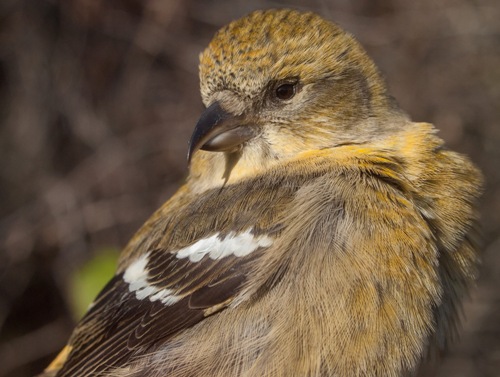 The streak of “new” species in fall carried over into November, with this White-winged Crossbill, the first of its kind banded at MBO, and species #111 overall. (Photo by Simon Duval)
The streak of “new” species in fall carried over into November, with this White-winged Crossbill, the first of its kind banded at MBO, and species #111 overall. (Photo by Simon Duval)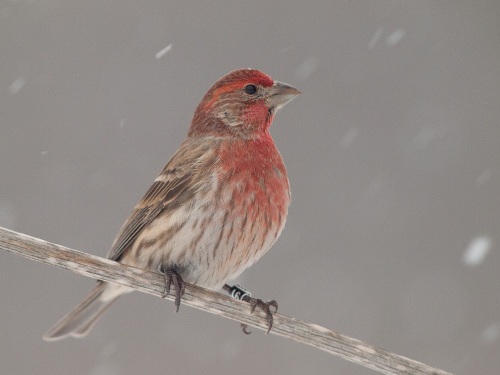 One of our colour-banded House Finches perching near the feeders. (Photo by Simon Duval)
One of our colour-banded House Finches perching near the feeders. (Photo by Simon Duval)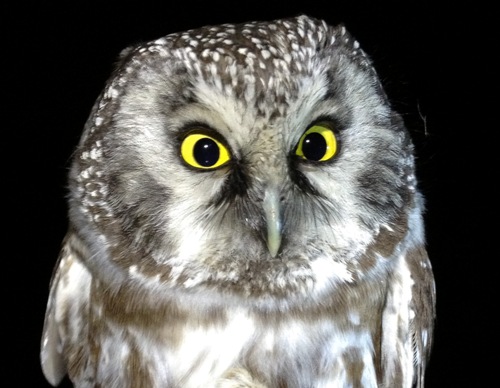 One of the four Boreal Owls banded at MBO in early November. (Photo by Simon Duval)
One of the four Boreal Owls banded at MBO in early November. (Photo by Simon Duval)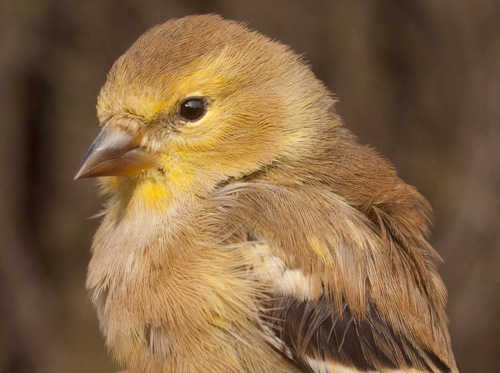 One of the nearly 150 American Goldfinches banded this November. (Photo by Simon Duval)
One of the nearly 150 American Goldfinches banded this November. (Photo by Simon Duval)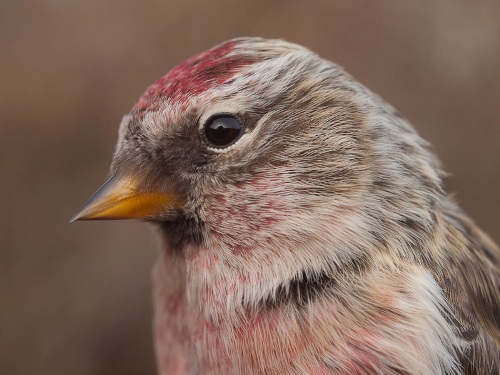 Common Redpolls started to arrive in good numbers in December, earlier than in past “big” years, raising hopes for even larger flocks in early 2013. (Photo by Simon Duval)
Common Redpolls started to arrive in good numbers in December, earlier than in past “big” years, raising hopes for even larger flocks in early 2013. (Photo by Simon Duval)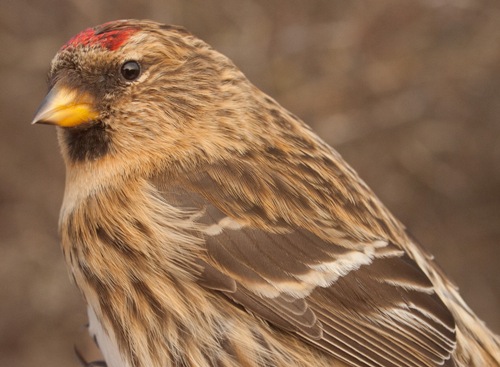 Among the Common Redpolls banded this month were two individuals of the rostrata subspecies, distinctly larger, browner, and more heavily streaked than the flammea subspecies which is more typical here in winter. (Photo by Simon Duval)
Among the Common Redpolls banded this month were two individuals of the rostrata subspecies, distinctly larger, browner, and more heavily streaked than the flammea subspecies which is more typical here in winter. (Photo by Simon Duval)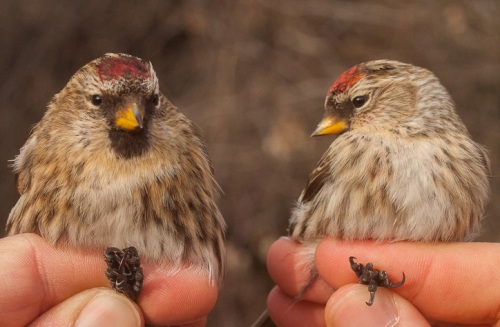 A comparison of two hatch-year female Common Redpolls – a larger, heavier, darker rostrataon the left, and a flammea on the right. (Photo by Simon Duval)
A comparison of two hatch-year female Common Redpolls – a larger, heavier, darker rostrataon the left, and a flammea on the right. (Photo by Simon Duval)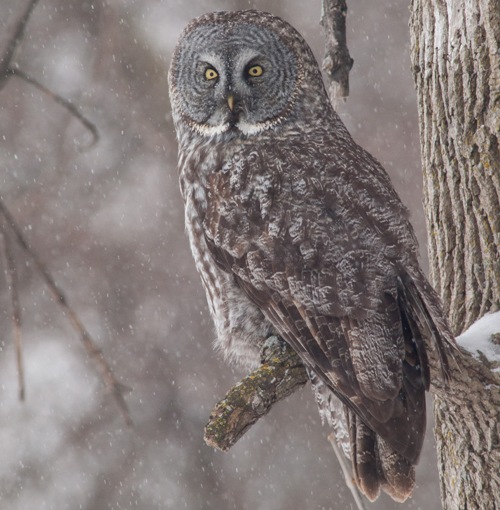 It was a cold and snowy month at MBO, but multiple sightings of this Great Gray Owl (the first record for MBO since 2005) were a highlight. (Photo by Simon Duval)
It was a cold and snowy month at MBO, but multiple sightings of this Great Gray Owl (the first record for MBO since 2005) were a highlight. (Photo by Simon Duval)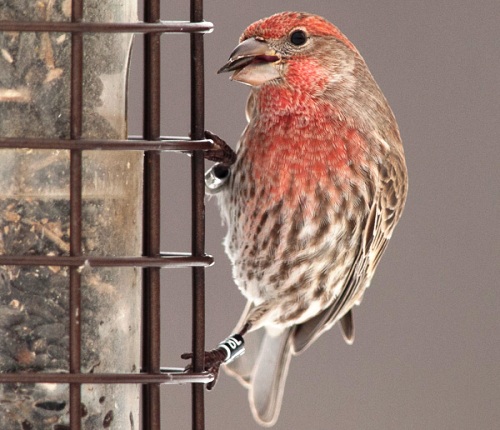 Among the many House Finches hanging around MBO in January were several individuals from our colour-banding study – enabling us to collect a number of valuable resighting records through observation and photography, despite not being able to open the nets this month. (Photo by Simon Duval)
Among the many House Finches hanging around MBO in January were several individuals from our colour-banding study – enabling us to collect a number of valuable resighting records through observation and photography, despite not being able to open the nets this month. (Photo by Simon Duval)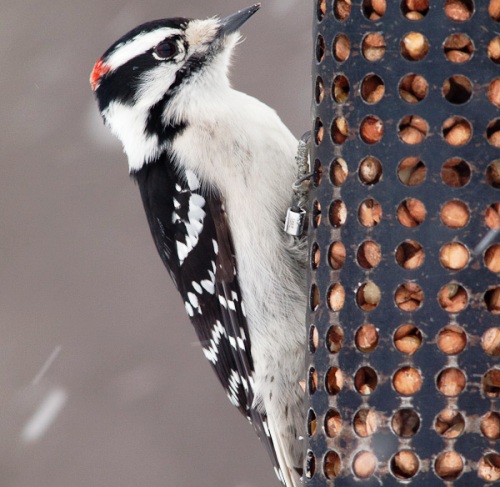 The woodpeckers remained active regardless of the weather this month. (Photo by Simon Duval)
The woodpeckers remained active regardless of the weather this month. (Photo by Simon Duval)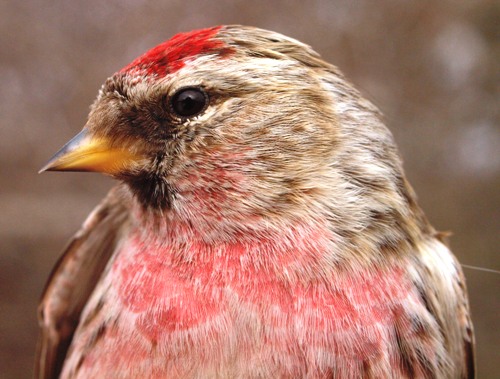 February was the month of the Common Redpoll at MBO, with 87 banded, including this boldly coloured after-second-year male. (Photo by Simon Duval)
February was the month of the Common Redpoll at MBO, with 87 banded, including this boldly coloured after-second-year male. (Photo by Simon Duval)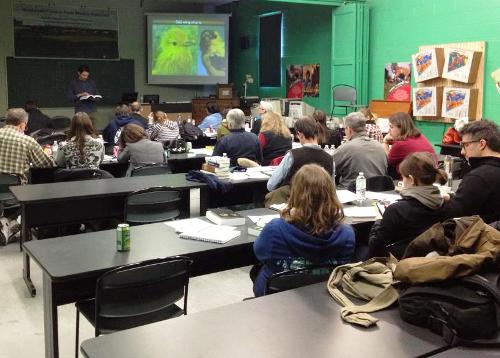 The participants at this year’s MBO molt and ageing workshop, taking notes while MRF Executive Director Marcel Gahbauer referenced a detail in Peter Pyle’s “Identification Guide to North American Birds”. (Photo by Simon Duval)
The participants at this year’s MBO molt and ageing workshop, taking notes while MRF Executive Director Marcel Gahbauer referenced a detail in Peter Pyle’s “Identification Guide to North American Birds”. (Photo by Simon Duval)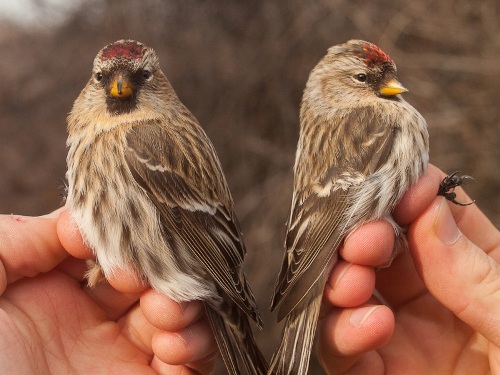 Here is a comparison of one of the rostrata Common Redpolls (left) and a flammea individual banded near the end of February. (Photo by Simon Duval)
Here is a comparison of one of the rostrata Common Redpolls (left) and a flammea individual banded near the end of February. (Photo by Simon Duval)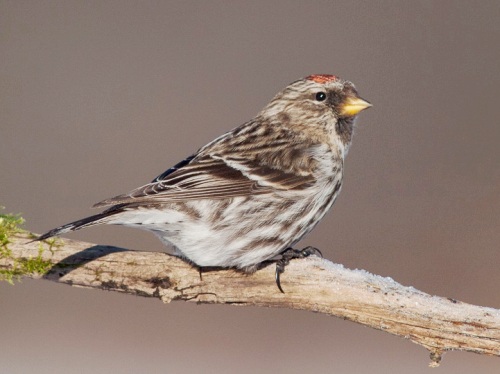 Common Redpolls remained the most abundant bird by far in March. (Photo by Simon Duval)
Common Redpolls remained the most abundant bird by far in March. (Photo by Simon Duval)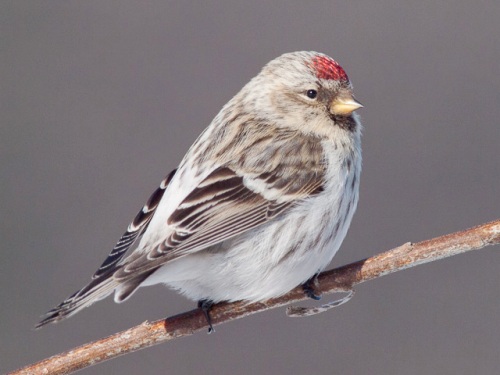 Among the many Common Redpolls present at MBO this winter, there were also a few Hoary Redpolls like this one. (Photo by Simon Duval)
Among the many Common Redpolls present at MBO this winter, there were also a few Hoary Redpolls like this one. (Photo by Simon Duval)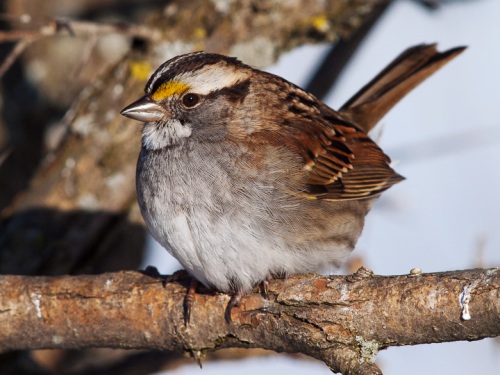 It was a good winter for White-throated Sparrows at MBO, with 8 banded over the course of the season, and at least a couple of individuals observed near the feeders during most visits throughout the season. (Photo by Simon Duval)
It was a good winter for White-throated Sparrows at MBO, with 8 banded over the course of the season, and at least a couple of individuals observed near the feeders during most visits throughout the season. (Photo by Simon Duval)